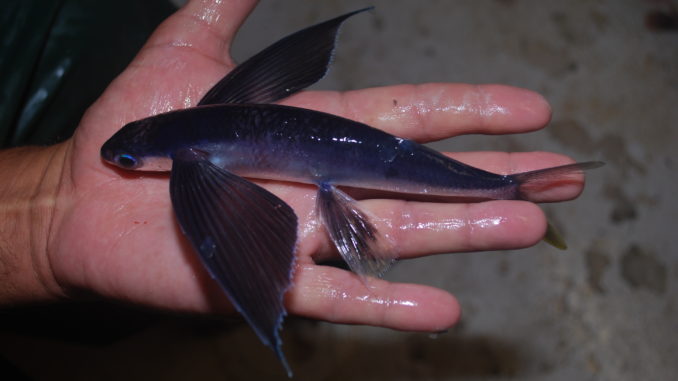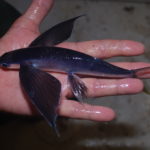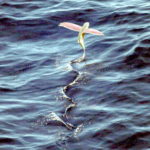
It’s … a fish?
If it’s not a bird and it’s not a plane and it’s over the ocean, its bound to be a flying fish, one of the most interesting fish in the Gulf of Mexico. Actually, there are more than one species of flying fish in the Gulf: 12 of them, in fact. Four of them are “monoplanes,” meaning that only their pectoral fins (the paired fins immediately behind the head) are enlarged for soaring. Eight of them are “biplanes.” They not only have enlarged pectoral fins, but large pelvic fins (the other set of paired fins), as well.
Most anglers who have spent more than a day on blue water in the Gulf have seen them, usually skittering away from the boat or its wake. But many anglers have never seen one up close, and even fewer have had a chance to watch their behavior when they are not soaring away from them.
A couple of years ago, I spent two weeks on a commercial snapper boat. Much of the time, we fished bandit reels at night under bright deck lights, about 110 miles south of Cameron. Watching the flying fish in the midnight blue but crystal clear water was fascinating. At times, hundreds of them would be on the water’s surface around the boat, running down and eating tiny little critters.
Most of them moved and maneuvered with their massive pectoral fins spread like butterflies. Even when they weren’t moving, they kept their fins spread as if they were hovering. When jacks or a squadron of voracious dolphin slashed into sight, grabbing everything small enough to swallow, the water would explode with fleeing flying fish.
The books say that they can’t really fly (as in flap their fins), but rather only coast. But their fins made a sound completely reminiscent of that of flying grasshoppers. The books also say that they have to take a running start to get in the air. Well, these exploded from dead stop in the water to instantly being airborne.
Their velocity was impressive. One sailfin flying fish jumped from the water 4 feet from the boat and hit the hull with an impressively loud thud. The fish hit so hard, with no running start, that it broke its back behind the head. Its little body floated on the surface with the head at a right angle to the body.
Of course, books say that bumble bees can’t fly either.
Flying fish are found worldwide in the tropics and subtropics. Excluding their very close family members, the balao, the ballyhoo and halfbeaks, there are more than 50 different species. And they exist in huge numbers.
They are important food items for fast-swimming predator fish, such as dolphin, jacks, tuna and billfish, all of which spend much of their time on the ocean’s surface — flying fish habitat. They are also apparently eaten by sea birds, porpoises and squid. In turn, flying fish themselves are predators, feeding voraciously on small fish and crustaceans.
Their predatory habits allow them to be caught be determined fly fishermen using tiny flies. Probably more of them are taken “on the wing” with shotguns using low-power fine shot than with flies. (Yes people do this. People do strange things for a fish.) The bagged flying fish can be scooped with a dip net because they float like a cork.
Spawning, like everything else these fish do, takes place in surface waters. They lay sticky, heavier-than-water eggs that will sink to the bottom if not attached to something floating. At least some species lay their eggs in sargassum clumps. Sometimes so many eggs are attached that the seaweed will barely float.
The flight of flying fish has long amazed humans. The Latin name of the family, Exocoetidae, is a translation of an ancient Greek name for flying fish that literally means “sleeping outside” and “bed” or “resting place.” Apparently the ancients believed that they flew from the water to sleep on the shore. “Excocet” is the Fench name for flying fish and the name given to their famously effective anti-ship missile.
“Flying” is done by the fish beating its tail fin very rapidly, up to 70 times per second. (That’s a lot. Think about it.) When it gets up enough speed, it spreads its pectoral fins and tilts them slightly upward to provide lift. As the fish planes up out of the water, the elongated lower lobe of the tail continues to scull the surface of the water for a final power boost.
Four-winged species are larger (up to 18 inches long) than two-winged species and can glide longer, at least a quarter of a mile, although most “flights” are shorter. At the end of the flight, the fish can either hit the water or glide down to the surface so that the lower lobe of the tail can be used to scull the fish up to speeds enough for another flight.
Four-winged flying fish can fly faster (over 40 m.p.h.), and have the ability to use their second set of finny wings to somewhat change the course of their flight in mid-air.
Flying fish are not just enjoyed by fish, birds and porpoises. People eat them too. Most sushi lovers have eaten tobiko, flying fish roe. Its natural color is red-orange, but it may be dyed green with wasabi or black with squid ink.
Less exotically, it is considered the most important food fish in the eastern Caribbean, particularly the countries of Barbados and Trinidad and Tobago. In 2006, the United Nations had to intervene in a flying fish fishing dispute between the two countries.
Barbados, nicknamed “land of the flying fish,” has flying fish as its official national fish, as well as, when fried or steamed, part of its official national dish, “cou-cou.” Barbados is also home for flying fish pie, a layered dish of flying fish, tomatoes, onions and boiled eggs, covered with brown gravy and then topped with fluffed potatoes before being baked in the oven.




